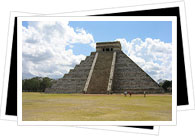
Chichen Itza is one of the most prominent Maya archaeological sites in Mexico. In its hey-day Chichen Itza was the center of economic, political and cultural life in the northern Maya lowlands. That is why you can see a lot of structures here, ranging from the Late Classic to the Terminal Classic and on to the Early Post-classic era.
The name Chichen Itza means “at the mouth of the well of Itza.”
Cenotes
There are two existing natural sinkholes, or cenotes, that provide the city's water suppy. The more famous is the “Cenote of Sacrifice”, which was revered by the Mayans in their worship of Chaac the Maya rain god. The Mayans made offerings of pottery incense and jade which were thrown into the well. Some even go as far as saying that many beautiful virgins were also offered and cast into the well, but these have no written proof in any of the records.
Chiche Itza boasts Mayan palaces, ball courts, baths, markets and temples.
Here are some buildings in Chichen Itza that are of great interest:
El Castillo
Only two of the four sides of this building have been restored. This is the most prominent of the structures. At the foot of its staircase are large sculptures of serpent's heads. Climb on top of this structure and you will be rewarded with a stunning view of the city and all of the ruins there.
El Castillo is really two buildings, one of which was placed on top of the other. The newer pyramid has nine platforms and is said to symbolize the region of the dead.
Temple of Kukulcan (Quetzalcoatl)
This pyramid has stairways on four sides and these lead to the top. This is named after the plumed serpent, Kulkulcan, whose shadow moves over the pyramid on the spring and fall equinox. These two days are the most awaited for this building, as people gather to watch the movement of the shadow of the snake along with the movement of the sun.
Temple of the Warriors
This stepped pyramid is named after the sculptures of warriors on its supporting columns and on the pillars at the front. The temple's cornices are covered with motifs including images of jaguars and heart-eating eagles. There are also images of Kukulcan and a statue of Chac Mool, the Mayan rain god.
Ball Court
In Maya cities in the Yucatan, you can usually find a ball court. However, the ball court in Chichen Itza is the largest and the most well reconstructed. In fact, the ball court in Chichen Itza is the largest in all of ancient Mesoamerica. Measuring 166 by 68 meters, the court is adorned with panels that show ball players. The scene shows the beheading of a player.
The ball court has sloping walls which support temples. These temples were used for ceremonies and rituals during the days when the games were played. There are two stone scoring rings adorned with serpent on opposite sides of the court. It is said that, in order to score, the players were supposed to pass a ball through the ring. They were not allowed to use their hands.
Las Monjas (The nunnery)
This is an example of the Puuc architectural style. It was just nicknamed so, but the building was actually used as a governmental palace.
Aside from these you can also visit:
- Temple of the Jaguars
- The Observatory
- The Red House
- The House of the Deer
- The Platform of the Snail (El Caracol)
Caves of Balankanche
Near Chichen Itza, you can also take a side trip to the Caves of Balankanche. This is a network of caves that were held sacred by the Mayans.